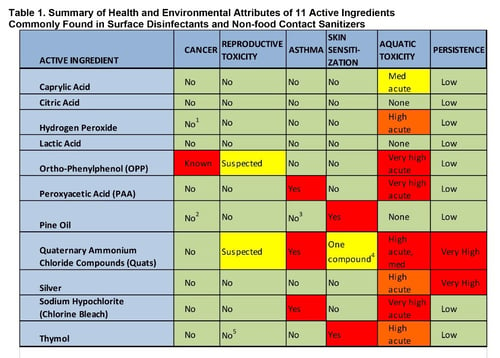Don't Kid Around with Cleaning: Considerations When Choosing Disinfectants for Schools
Although the classrooms are empty right now, school districts across the country are busy investigating options for reopening their buildings in autumn 2020. The safety of their students and staff is one of the critical factors in their decisions. How can facilities minimize exposure to the coronavirus? What’s the best way to protect student and staff health? How should schools change current protocols to be successful?
Properly cleaning and disinfecting areas children and adult staff will be occupying are key to any facility reopening plan. It’s important to remember that cleaning and disinfecting are two separate activities, although many people use the terms interchangeably. Cleaning refers to the removal of visible dirt and debris, usually using soap and water, although sometimes special cleaning chemicals are used. Wiping off desks with a damp cloth is an example of cleaning. Disinfecting is a process of killing germs, bacteria, and other pathogens. Using bleach in a toilet bowl could be an example of disinfecting.
Because the goal of disinfecting is eradicating as much of the harmful microorganisms as possible, many chemicals used as disinfectants can be harmful to humans. The EPA considers disinfectants to be pesticides, since they’re used for “preventing, destroying, repelling or mitigating any pest,”1 and requires detailed information about their toxicity, safety precautions, etc. Any disinfectant that will be used in a school setting should be an EPA-registered product. When a cleaning and disinfecting plan is designed for areas where young children will be present, it’s important to make sure that the students won’t be at a greater risk for illness from the cleaning chemicals than from viruses and other pathogens.
Children are more vulnerable to the ingredients of the some of the most popular disinfectants for many reasons:
- Children breathe up to 6 times more air than adults, and they breathe closer to the ground where air pollutants can concentrate.
- Children have more skin covering their bodies relative to their weight than adults, so they can absorb more potential toxicity.
- Children have more skin contact with the floor because of their size and behavior.
- Children’s hand-to-mouth behavior means they eat more dust and residue than adults. These may contain many toxic chemicals from cleaning products, pesticides, furnishings, and other sources.2
Choosing the best cleaning and disinfecting chemicals for an educational facility means reading the ingredients list carefully and noting any potential problems these chemicals might cause, such as asthma or skin sensitivity. For example, this table from the San Francisco Department of the Environment shows the attributes of eleven active ingredients commonly found in disinfectants:3

The chemical labels should also list any personal protective equipment required for use and detailed directions. One common way that that disinfectants are used incorrectly is being wiped or rinsed off too quickly. If the surface doesn’t remain wet with the chemical for the minimum time listed on the label, then the germs might not have been killed, and the surface could still harbor pathogens.
Choosing the right cleaning supplies for schools has never been more important than it is in the current pandemic situation. There are government resources, including the CDC and the EPA, that provide helpful information on decision-making factors. Here at Contec Professional, we are proud to partner with our customers, helping them make their schools clean, safe, and healthy places for success. For more information on how we can help you clean and disinfect your educational facilities, please visit www.ContecProfessional.com to set up a virtual consultation.
References1 https://www.epa.gov/pesticide-registration/about-pesticide-registration2 https://www.epa.gov/sites/production/files/documents/ece_curriculumfinal.pdf3 https://sfenvironment.org/sites/default/files/fliers/files/sfe_th_safer_products_and_practices_for_disinfecting.pdf
